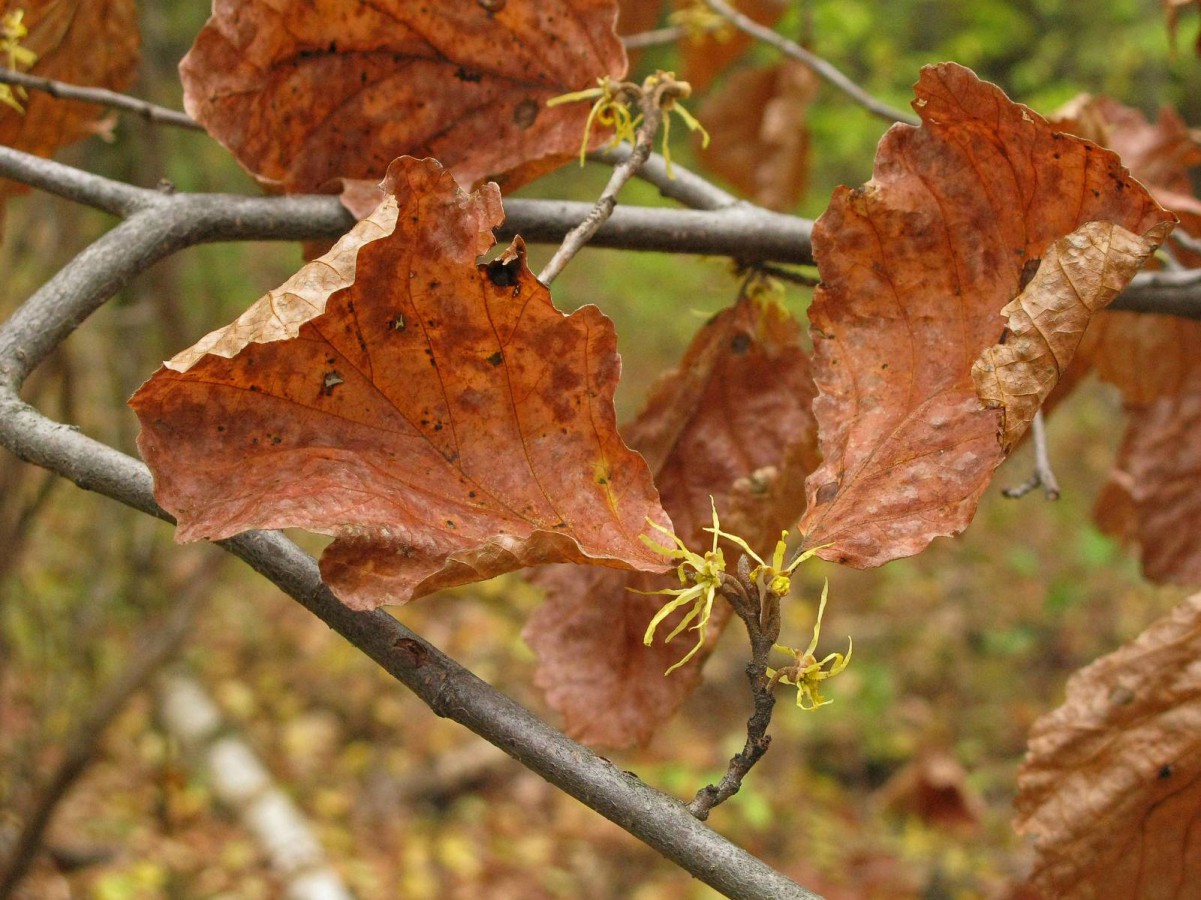While trees and the flowering herbs that grow at their feet monopolize most of the botanical limelight, shrubs must not be overlooked. They unfurl some of our prettiest flowers, supply much of our tastiest and energy-rich fruit, offer nesting habitat for birds, and provide shelter during harsh weather to creatures great and small.
Among Finger Lakes shrubs, one species stands out, not so much as the best for housing and feeding animals or floral color, but as the weirdest. I refer to Hamamelis virginiana, better known as witch-hazel.
Witch-hazel has the peculiar habit of opening its flowers for business not in warm, sunny spring or summer, but during cold, hard November or December. It’s bizarre. “Winterbloom” is a name for this plant. So is “snapping alder,” for the fact that the leaves resemble those of alders and their fruits open with loud cracks. When witch-hazel pods burst, the bullet-like seeds may shoot ten or twenty feet.
Why blossom in autumn or winter when pollinators are scarce? It’s an open question. Certainly with nothing else in bloom, witch-hazel has little trouble attracting the attention of whatever insects are active. Studies have shown that for witch-hazel, Cupid’s errands are carried out by a variety of cold-weather fliers, among them fungus gnats, parasitic wasps, and hoverflies.
As in all so-called higher plants, pollen delivers the sperm that fertilize eggs cradled in ovaries. An odd thing about witch-hazel embryos is that after they’re created, they’re put on hold. It’s winter, after all. The plant is virtually shut down physiologically and in no position to manufacture fully developed offspring. So the embryos are archived until spring. Then they begin developing in earnest.
Botanically, witch-hazel is a lone wolf, at least in New York state. It has no close relatives here. Most of its kin live in Asia, although a second, smaller kind of witch-hazel occurs in the American South. Sweetgum trees, ranging from Dixie northward to the coast of Connecticut, also hail from the same off-beat family.
When I was a child, my mother treated major body aches in the household with witch-hazel rubdowns. The liniment, still sold in drugstores, wafts a distinctive medicinal smell that inspires faith (possibly misguided) in its curative powers. Witch-hazel essence, which also turns up in toothpaste and facial cleansers, is distilled from the twigs. Oddly, there’s little or no whiff of the final, astringent product in the plant itself. Old-time pharmacists made witch-hazel lotion by pulverizing young twigs and roots and steeping them in alcohol. Regarding genuine health benefits, the jury remains out.
There are several stories explaining how witch-hazel got its name. The most colorful (and perhaps least reliable) is that the plant, flowering around or after Halloween and with its crooked growth habit, gangly yellow blossoms, and explosive seedpods, was historically associated with witches. Dowsers, also known as water-witchers, sometimes choose forked sections of witch-hazel as divining rods.
More credible theories center on the word wych, an old English sound-alike of “witch.” The witch-hazel found by early English settlers in northeastern North America likely reminded them of the wych-elm (Ulmus glabra), a widespread English tree, and of English hazels (genus Corylus), which are close relatives and look-alikes of our native American hazelnuts. “Wych” is an old word for “water.” It probably refers to the English tree’s tendency to grow in wet places. “Wych” also derives from the same linguistic root as “wicker” and may refer to the plant’s bending stems. Either way, witch-hazel’s striking name likely has no connection to women who don black pointed hats and traverse the night sky on broomsticks.
When looking for witch-hazel, keep your eyes peeled for many-trunked bushes, some as tall as you are, or taller, with brown or gray-brown bark. In November and December, the broad, glossy leaves will be down, but rummage on the ground or in the snow and you may find a few. Observe the leaves’ distinctive wavy edges. If the flowers are out, you’ll see that they’re yellow and adorned with four long, skinny, arthritic-looking petals.
One more thing. Witch-hazel is singular in that its flowers and ripe seedpods (the fruit, literally, of the previous year’s flowers) appear at the same time. The capsules are hard and knobby, angular but vaguely spherical, and measure about a half-inch across. Watch out for them. Hike through a patch of witch-hazel at the moment the seeds are fully ripe, and bullets may come a-flying!


